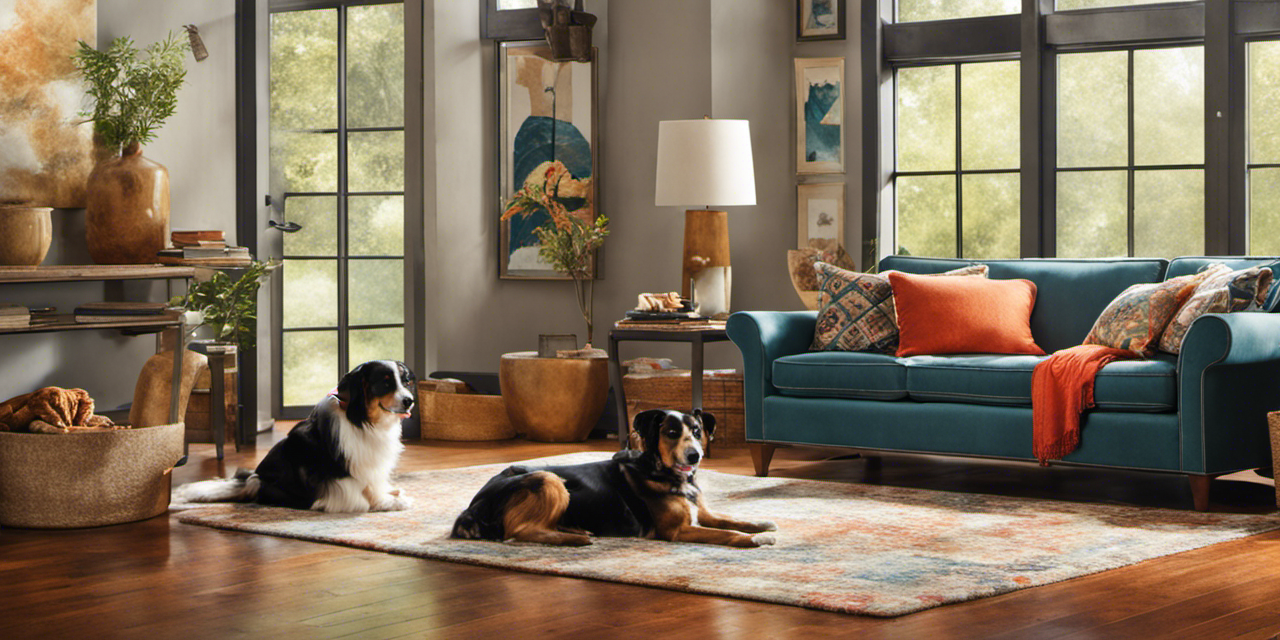Embracing our Furry Friends and Their Little Challenges: Understanding common pet stains and odors
Cherishing our pets indeed fills our hearts with joy. Yet, the little accidents they sometimes leave behind, including urine stains, vomit spots, fecal marks, and muddy paw imprints, can slightly mar this joy. Understanding the nature of these pet stains and odors is the initial stride in tackling them effectively.
The Types of Pet Stains and Their Challenges
Pets may leave an assortment of stains, each of which requires a specific cleaning strategy. Here's a quick rundown:
- Urine Stains: These are perhaps the most common, especially with puppies and kittens. Urine stains can be tricky to handle due to the stubborn odors they leave behind.
- Vomit Spots: Cats, in particular, are known for leaving these behind. Acidic vomit can discolour or damage certain surfaces.
- Fecal Marks: Apart from being unsightly, fecal stains often come with a strong, unpleasant odor that can linger if not thoroughly cleaned.
- Muddy Paw Prints: These may not leave a smell but can be difficult to remove, especially on porous surfaces.
It's crucial to identify the type of stain you're dealing with to deploy the most appropriate cleaning solution.
Understanding Pet Odors
Where there are pet stains, there's bound to be an associated odor—another unwanted consequence of our pets' little accidents. Identifying the source of these odors is critical to effectively treat and neutralize them.
- Urine Odor: This is the most prevalent and persistent of pet odors. It's caused by bacteria that break down the urea in the urine, releasing an unpleasant ammonia-like smell.
- Fecal Odor: It's usually less persistent than urine odor but can be just as distressing.
- Body Odor: Our fur friends also produce body odors, usually from their skin or fur oils, which can transfer to furniture or other surfaces.
In addition to understanding pet stains and odors, it's vital to act promptly when an accident happens. Immediate action can prevent stains from setting in and odors from permeating your home.
In the next section, we'll delve into cleaning techniques for effectively removing pet stains and odors from various surfaces in your home.
The Cleaning Journey: Adopting Effective Techniques to Eliminate Stains from Carpets, Hardwood Floors, and Upholstery
A crucial piece of the puzzle in pet stain and odor removal is understanding the cleaning process. Here we'll address how to tackle these issues across different surfaces in your home.
Carpets and Rugs: The Frontline in the Battle Against Stains
Carpets and rugs often bear the brunt of pet accidents. Quick response is key in these cases. Blot up fresh stains using a clean cloth to absorb as much as possible. For maximum effectiveness, employ a specialized carpet cleaner designed to combat pet stains. In situations where the stain has set, a specially formulated carpet stain remover can act effectively as your secret weapon.
Hardwood Floors: Beautiful but Susceptible
While hardwood floors add charm to your home, they are also vulnerable to pet stains. As soon as any spillage occurs, wipe it down. By doing so, you avoid the liquid penetrating the wood, which might cause long-lasting damage. Then, use cleaning solutions specifically crafted for hardwood floors to maintain their elegance.
Upholstery and Furniture: The Comfort Zone for Pets
Our pets love snuggling on our furniture, occasionally leaving stains and odors in their wake. For quick fixes, spot-cleaning with mild detergent solutions can help. However, for more stubborn stains, considering steam cleaners or professional upholstery cleaning services might be necessary.
| Surface | Process | Tip |
|---|---|---|
| Carpets and Rugs | Blot, then use a carpet cleaner | Act quickly |
| Hardwood Floors | Wipe, then use a floor cleaner | Maintain their elegance |
| Upholstery and Furniture | Mild detergent or professional cleaning | Might require steam cleaning |
As part of your journey towards superior pet stain and odor removal, getting familiar with these cleaning techniques is essential. With the appropriate approach for each type of surface, you can maintain a clean and inviting space for both you and your pets.
The Scent of Cleanliness: Eliminating Pet Odors for a Fresher Home
Having a clean home is about more than just appearances; it's also about the smell. Pet odors can be stubborn and off-putting, but with the right strategies, you can keep your home fresh and inviting.
Start by identifying and locating the source of the smell. Once you've found it, use natural deodorizers like baking soda and vinegar. These common household items are excellent for neutralizing odors and are safe to use around pets.
For a more powerful solution, consider pet-specific odor-neutralizing products. They are designed to combat pet smells and can add long-lasting freshness to your home.
Use the following table as a guide to ensure effective pet stain and odor removal:
| Source of Odor | Cleaning Method | Additional Considerations |
|---|---|---|
| Urine | Baking soda and vinegar | Act quickly to prevent the smell from setting in |
| Vomit | Pet-specific odor-neutralizing products | Test in an inconspicuous area first |
| Faeces | Baking soda and vinegar | Dispose of waste promptly |
| General Pet Smell | Regular cleaning and ventilation | Use air purifiers if needed |
The scent of cleanliness is not only about eliminating pet odors but also about maintaining a pleasant and welcoming atmosphere in your home. By implementing these strategies, you are ensuring a fresh and inviting environment for everyone, including your furry friends.
Preventive Measures: Proactive Strategies for Pet Stain and Odor Prevention
While dealing with pet stains and odors is necessary, preventing them from happening in the first place is even better. Here are some proactive strategies you can adopt to make your pet stain and odor removal process more manageable.
Teach your pets proper bathroom etiquette. Animals can be trained to answer nature's call in specific areas, reducing the likelihood of accidents elsewhere in the home. Consider having a designated pet area with easy-to-clean flooring.
Utilize deterrents and odor eliminators. These can help discourage pets from re-soiling certain areas. Some products can even eliminate residual smells completely, preventing your pet from returning to the same spot out of habit.
Maintain regular grooming routines. Regular bathing and brushing of your pets helps to minimize shedding and distribution of pet odors throughout your home. Plus, it keeps your pets clean and healthy!
Invest in washable pet bedding and blankets. This simplifies cleaning and allows you to control odors and reduce allergens caused by pet dander.
Always keep spot cleaning supplies handy. This ensures you can tackle stains and spills promptly, preventing them from setting in and causing long-term damage to surfaces.
| Strategy | Benefit |
|---|---|
| Pet Training | Reduces frequency and severity of accidents |
| Deterrents and Odor Eliminators | Prevents repeated soiling of same area |
| Regular Pet Grooming | Minimizes shedding and odors |
| Washable Pet Belongings | Facilitates cleaning and odor control |
| Stocked Cleaning Supplies | Swift response to unforeseen accidents |
Prevention is indeed better than cure. By combining these preventive strategies with efficient cleaning methods, you'll be well on your way to maintaining a clean and odor-free home.
Winning the Battle Against Pet Stains and Odors for a Clean, Inviting Home
The journey to maintaining a clean and odor-free home, even with pets, doesn't have to be a strenuous one. By understanding the types of stains and odors your pets can cause, knowing how to clean different surfaces in your home, eliminating pet odors, and adopting preventive measures, you've got all the tools you need for effective pet stain and odor removal.
Regularly cleaning your home is essential in controlling pet hair, dander, and lingering odors. This includes vacuuming your carpets, rugs, and floors frequently and cleaning your pet's bedding, toys, and other belongings.
Consider the use of air purifiers and ensuring your home is well-ventilated which can effectively remove pet dander, allergens, and odors from your home. These practices also help create a more inviting atmosphere for you and your guests.
Additionally, investing in enzymatic cleaners that break down the proteins in pet stains and eliminate odors should be a staple in your cleaning routine. Their unique formulation utilizes enzymes and bacteria to break down and neutralize the sources of smells, making them an integral part of your cleaning arsenal.
The combination of maintaining a regular cleaning routine, using efficient cleaning products, and adopting preventive measures will result in a clean and fresh home for both you and your pets. Consistency is key in this journey of pet stain and odor management, ensuring a healthy and pleasant living environment for all.
Here's a summary to streamline your pet-friendly home maintenance:
| Key Takeaways |
|---|
| Understand and identify common pet stains and odors |
| Adopt effective cleaning techniques for carpets, hardwood floors, and upholstery |
| Eliminate pet odors for a fresher home |
| Be proactive with strategies for pet stain and odor prevention |
| Maintain consistent cleaning routines |
| Utilize efficient cleaning products and air purifiers |
| Invest in enzymatic cleaners for effective odor neutralization |
With careful planning and execution, you'll be successful in winning the battle against pet stains and odors. At the end of the day, a clean and inviting home enhances the joy of sharing your space with your pets. Enjoy the countless benefits of a pet-friendly home that's clean, fresh, and welcoming to all!





